Analysis of PMBOK Framework and Uber Case Study Project Report
VerifiedAdded on 2022/12/26
|11
|1033
|63
Report
AI Summary
This report provides a detailed analysis of the Project Management Body of Knowledge (PMBOK) framework and its application to project management. It covers key areas such as stakeholder management, communication management, and procurement management, outlining the processes, tools, and techniques involved in each. The report explores how the PMBOK can be utilized for business and project improvement, emphasizing factors that contribute to project success and failure. It includes an analysis of the Uber case study, demonstrating the practical application of PMBOK guidelines in real-world scenarios. The report also discusses the importance of appropriate business cases, proper scope statements, team motivation, and effective leadership in achieving project success, while also addressing issues like inadequate tracking, unprofessional leadership, and skill deficiencies that can lead to project failure. Finally, the report highlights the characteristics of good and bad projects based on the PMBOK framework and includes references to relevant academic literature.
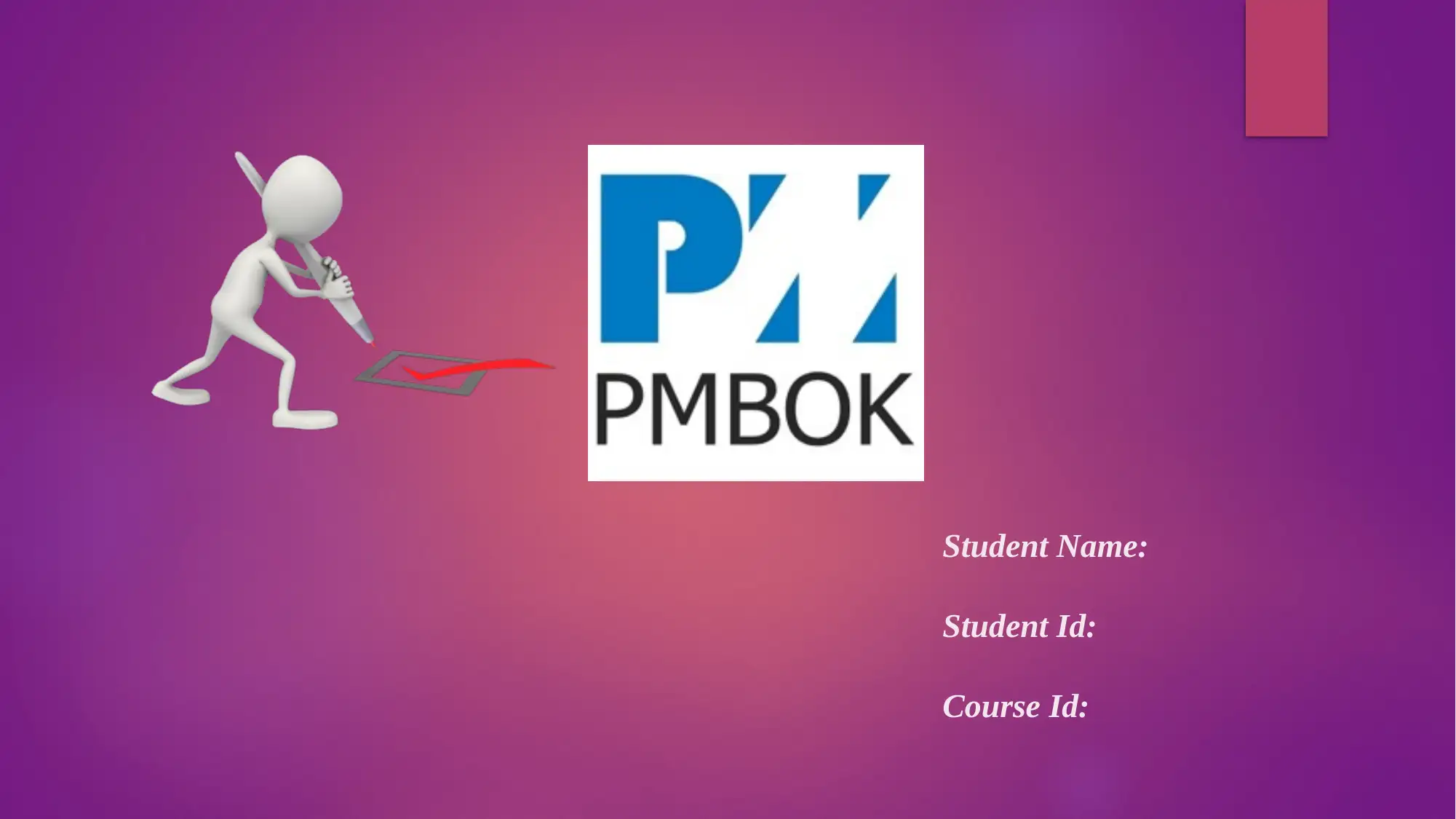
Student Name:
Student Id:
Course Id:
Student Id:
Course Id:
Paraphrase This Document
Need a fresh take? Get an instant paraphrase of this document with our AI Paraphraser
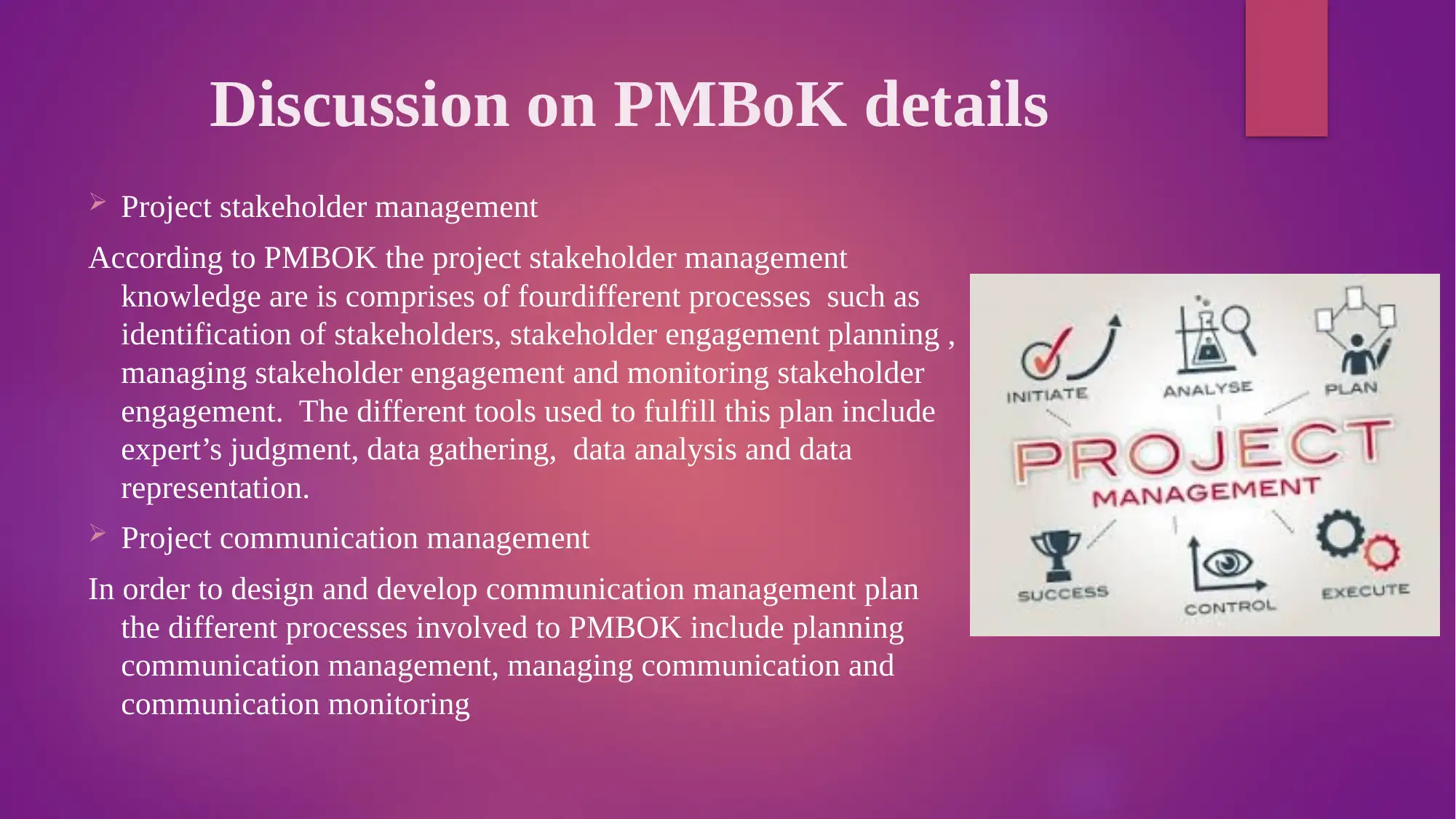
Discussion on PMBoK details
Project stakeholder management
According to PMBOK the project stakeholder management
knowledge are is comprises of fourdifferent processes such as
identification of stakeholders, stakeholder engagement planning ,
managing stakeholder engagement and monitoring stakeholder
engagement. The different tools used to fulfill this plan include
expert’s judgment, data gathering, data analysis and data
representation.
Project communication management
In order to design and develop communication management plan
the different processes involved to PMBOK include planning
communication management, managing communication and
communication monitoring
Project stakeholder management
According to PMBOK the project stakeholder management
knowledge are is comprises of fourdifferent processes such as
identification of stakeholders, stakeholder engagement planning ,
managing stakeholder engagement and monitoring stakeholder
engagement. The different tools used to fulfill this plan include
expert’s judgment, data gathering, data analysis and data
representation.
Project communication management
In order to design and develop communication management plan
the different processes involved to PMBOK include planning
communication management, managing communication and
communication monitoring
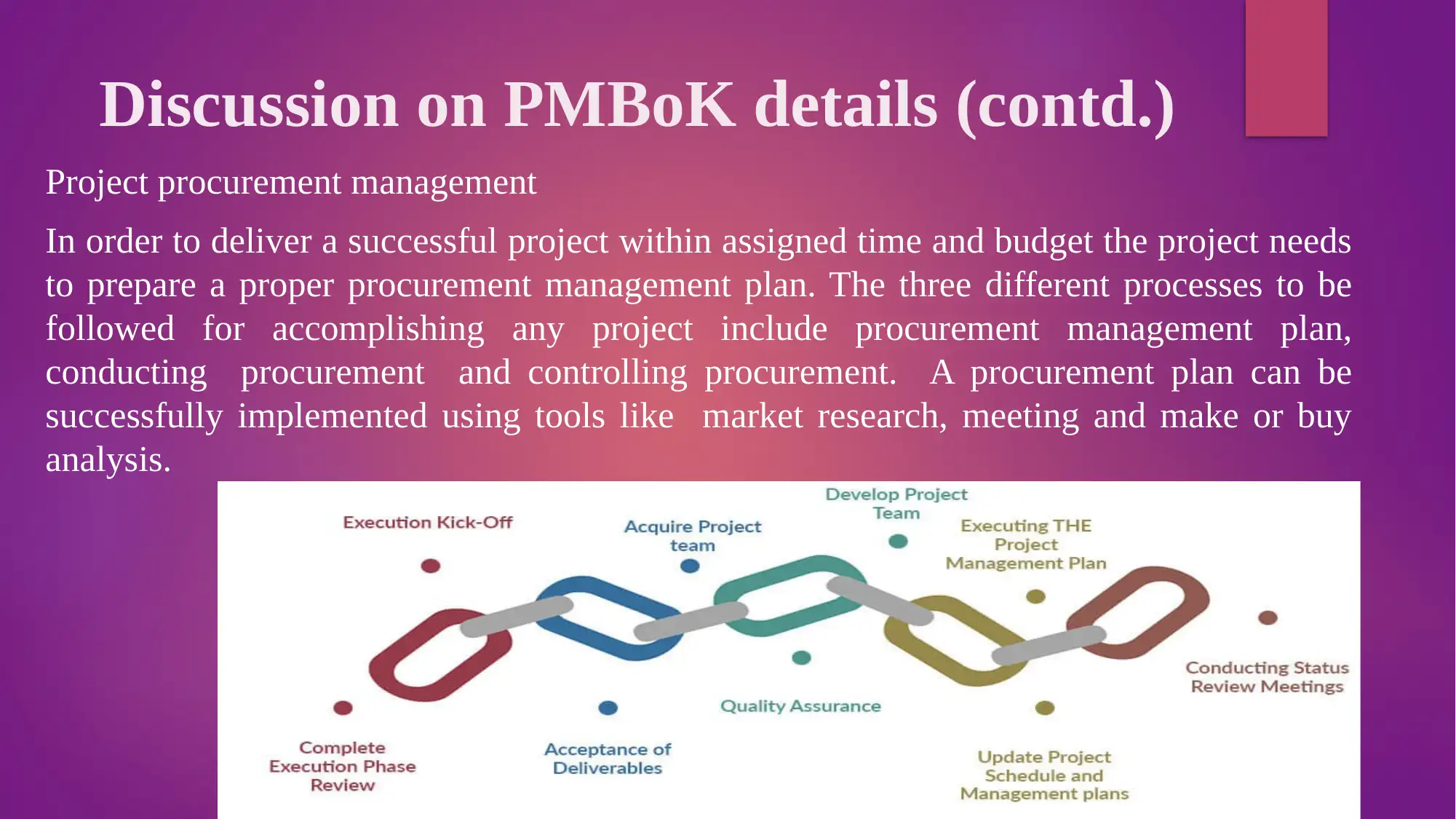
Discussion on PMBoK details (contd.)
Project procurement management
In order to deliver a successful project within assigned time and budget the project needs
to prepare a proper procurement management plan. The three different processes to be
followed for accomplishing any project include procurement management plan,
conducting procurement and controlling procurement. A procurement plan can be
successfully implemented using tools like market research, meeting and make or buy
analysis.
Project procurement management
In order to deliver a successful project within assigned time and budget the project needs
to prepare a proper procurement management plan. The three different processes to be
followed for accomplishing any project include procurement management plan,
conducting procurement and controlling procurement. A procurement plan can be
successfully implemented using tools like market research, meeting and make or buy
analysis.
⊘ This is a preview!⊘
Do you want full access?
Subscribe today to unlock all pages.

Trusted by 1+ million students worldwide
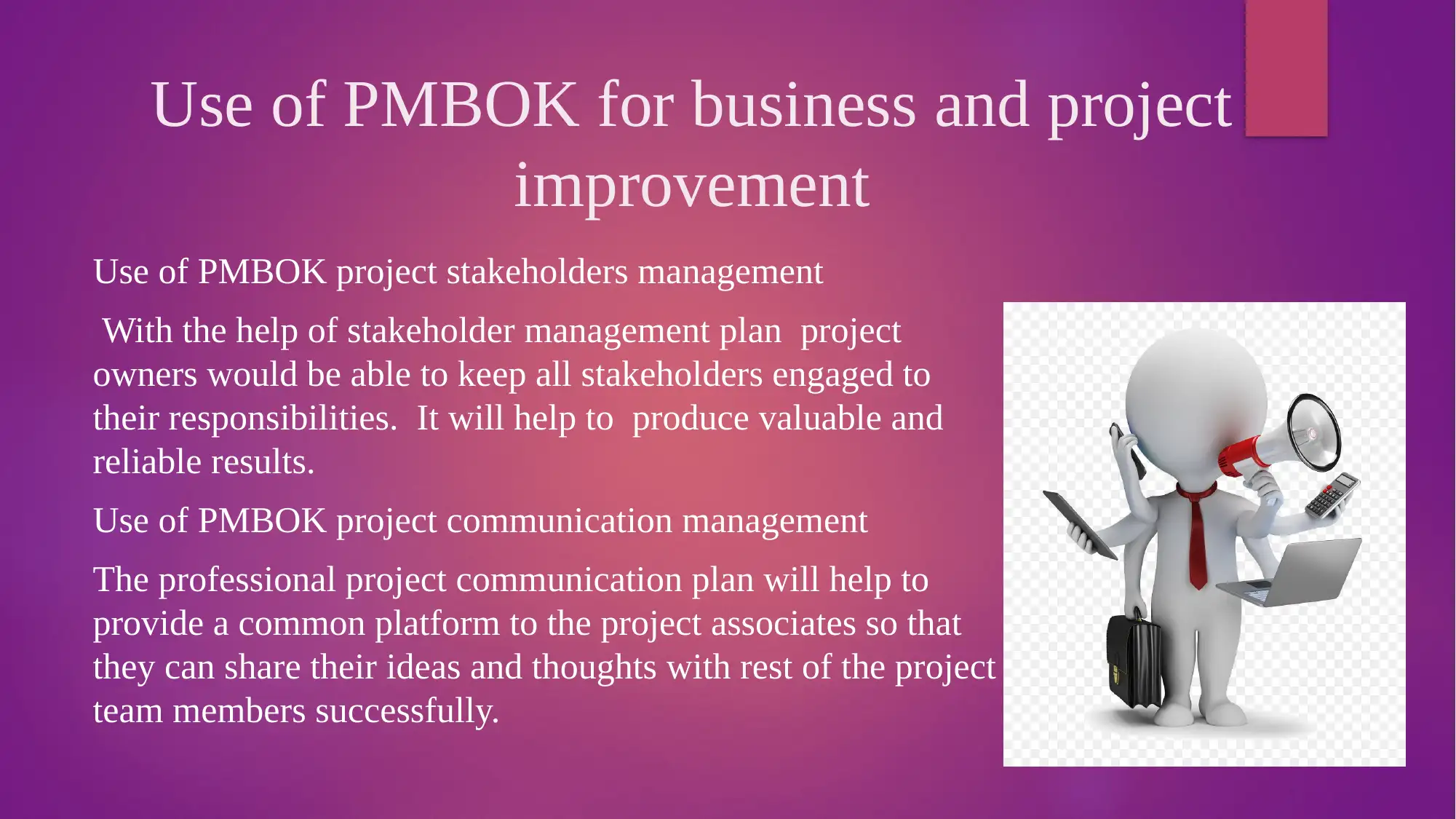
Use of PMBOK for business and project
improvement
Use of PMBOK project stakeholders management
With the help of stakeholder management plan project
owners would be able to keep all stakeholders engaged to
their responsibilities. It will help to produce valuable and
reliable results.
Use of PMBOK project communication management
The professional project communication plan will help to
provide a common platform to the project associates so that
they can share their ideas and thoughts with rest of the project
team members successfully.
improvement
Use of PMBOK project stakeholders management
With the help of stakeholder management plan project
owners would be able to keep all stakeholders engaged to
their responsibilities. It will help to produce valuable and
reliable results.
Use of PMBOK project communication management
The professional project communication plan will help to
provide a common platform to the project associates so that
they can share their ideas and thoughts with rest of the project
team members successfully.
Paraphrase This Document
Need a fresh take? Get an instant paraphrase of this document with our AI Paraphraser
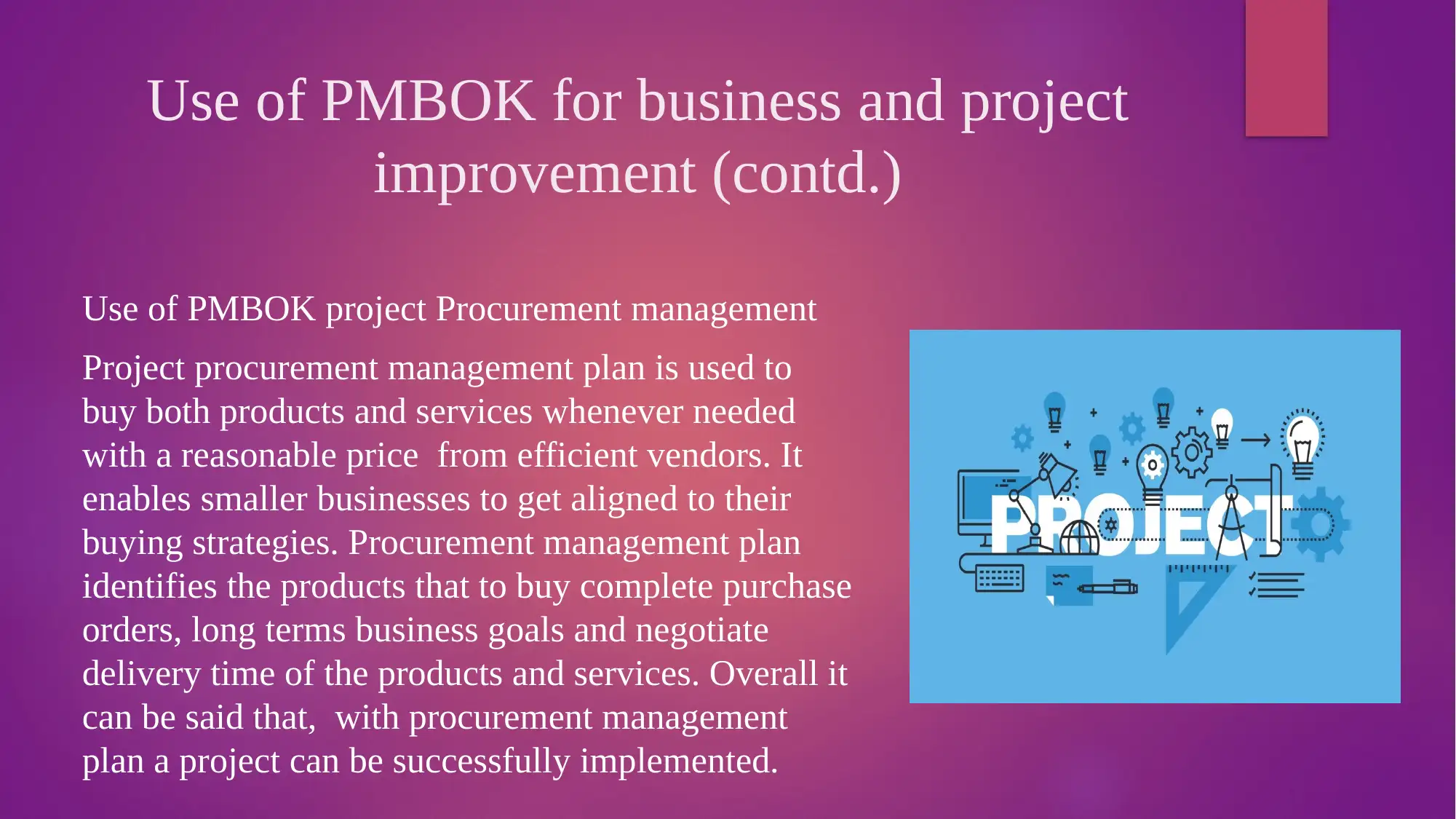
Use of PMBOK for business and project
improvement (contd.)
Use of PMBOK project Procurement management
Project procurement management plan is used to
buy both products and services whenever needed
with a reasonable price from efficient vendors. It
enables smaller businesses to get aligned to their
buying strategies. Procurement management plan
identifies the products that to buy complete purchase
orders, long terms business goals and negotiate
delivery time of the products and services. Overall it
can be said that, with procurement management
plan a project can be successfully implemented.
improvement (contd.)
Use of PMBOK project Procurement management
Project procurement management plan is used to
buy both products and services whenever needed
with a reasonable price from efficient vendors. It
enables smaller businesses to get aligned to their
buying strategies. Procurement management plan
identifies the products that to buy complete purchase
orders, long terms business goals and negotiate
delivery time of the products and services. Overall it
can be said that, with procurement management
plan a project can be successfully implemented.
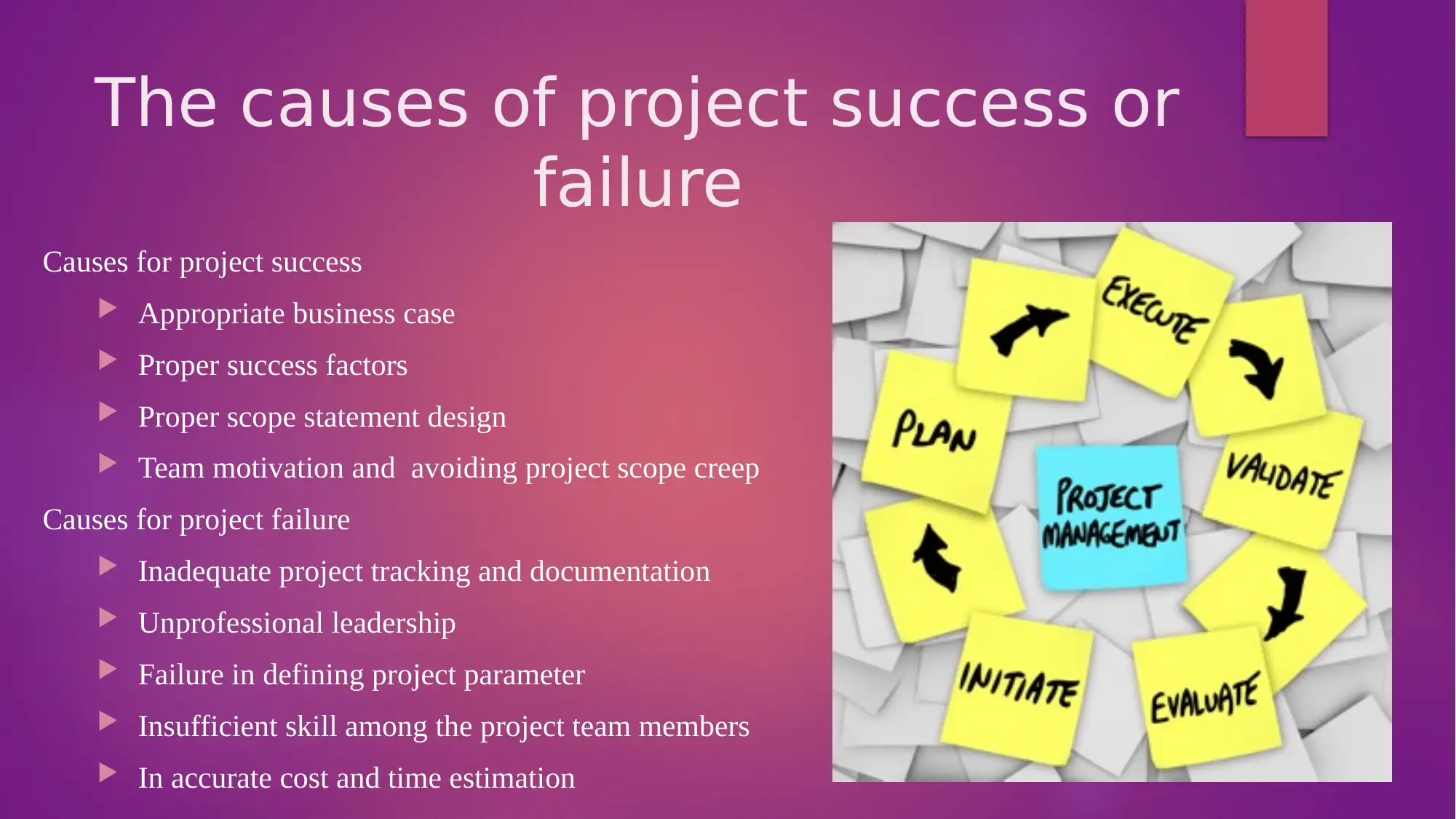
The causes of project success or
failure
Causes for project success
Appropriate business case
Proper success factors
Proper scope statement design
Team motivation and avoiding project scope creep
Causes for project failure
Inadequate project tracking and documentation
Unprofessional leadership
Failure in defining project parameter
Insufficient skill among the project team members
In accurate cost and time estimation
failure
Causes for project success
Appropriate business case
Proper success factors
Proper scope statement design
Team motivation and avoiding project scope creep
Causes for project failure
Inadequate project tracking and documentation
Unprofessional leadership
Failure in defining project parameter
Insufficient skill among the project team members
In accurate cost and time estimation
⊘ This is a preview!⊘
Do you want full access?
Subscribe today to unlock all pages.

Trusted by 1+ million students worldwide
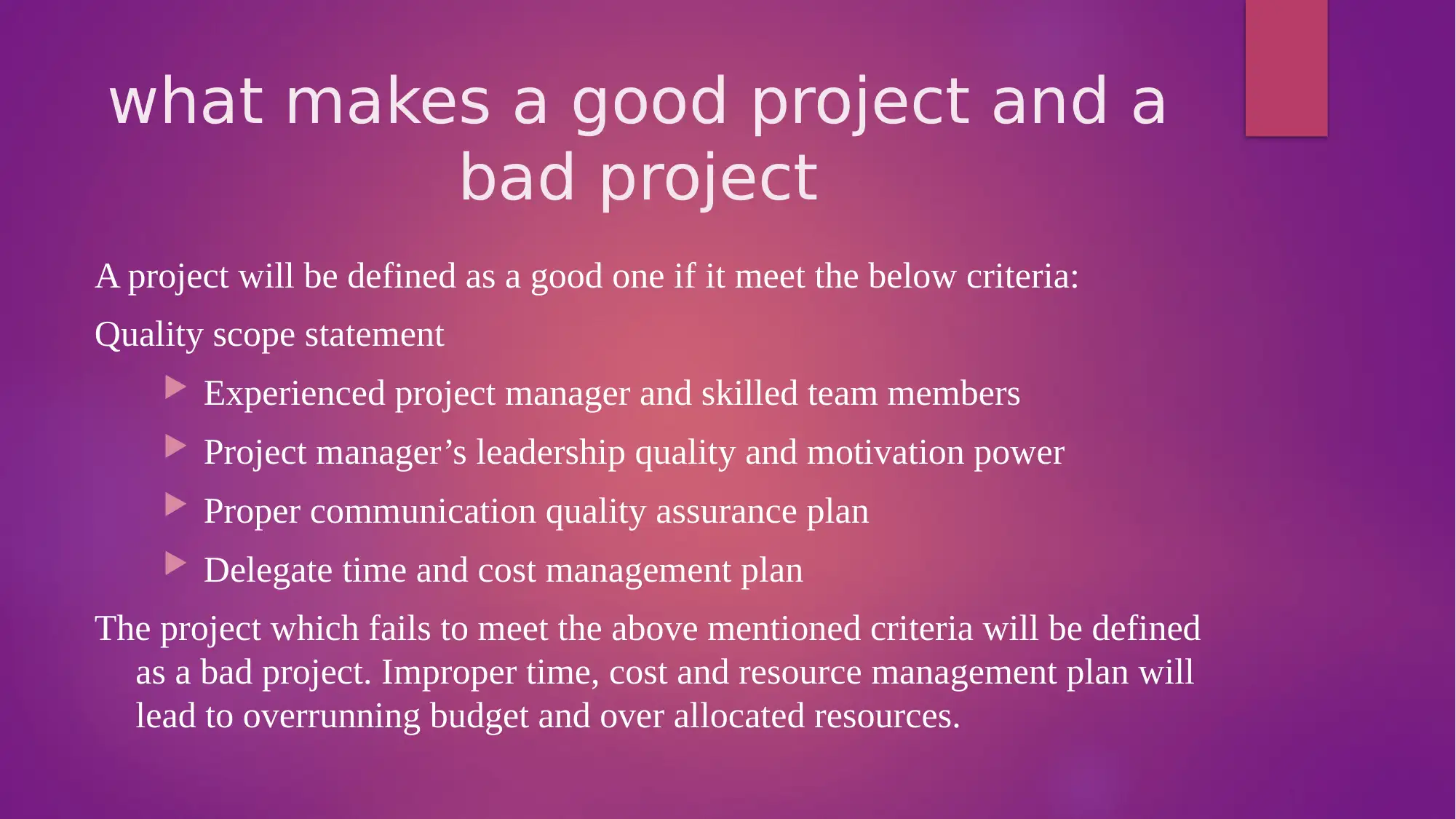
what makes a good project and a
bad project
A project will be defined as a good one if it meet the below criteria:
Quality scope statement
Experienced project manager and skilled team members
Project manager’s leadership quality and motivation power
Proper communication quality assurance plan
Delegate time and cost management plan
The project which fails to meet the above mentioned criteria will be defined
as a bad project. Improper time, cost and resource management plan will
lead to overrunning budget and over allocated resources.
bad project
A project will be defined as a good one if it meet the below criteria:
Quality scope statement
Experienced project manager and skilled team members
Project manager’s leadership quality and motivation power
Proper communication quality assurance plan
Delegate time and cost management plan
The project which fails to meet the above mentioned criteria will be defined
as a bad project. Improper time, cost and resource management plan will
lead to overrunning budget and over allocated resources.
Paraphrase This Document
Need a fresh take? Get an instant paraphrase of this document with our AI Paraphraser
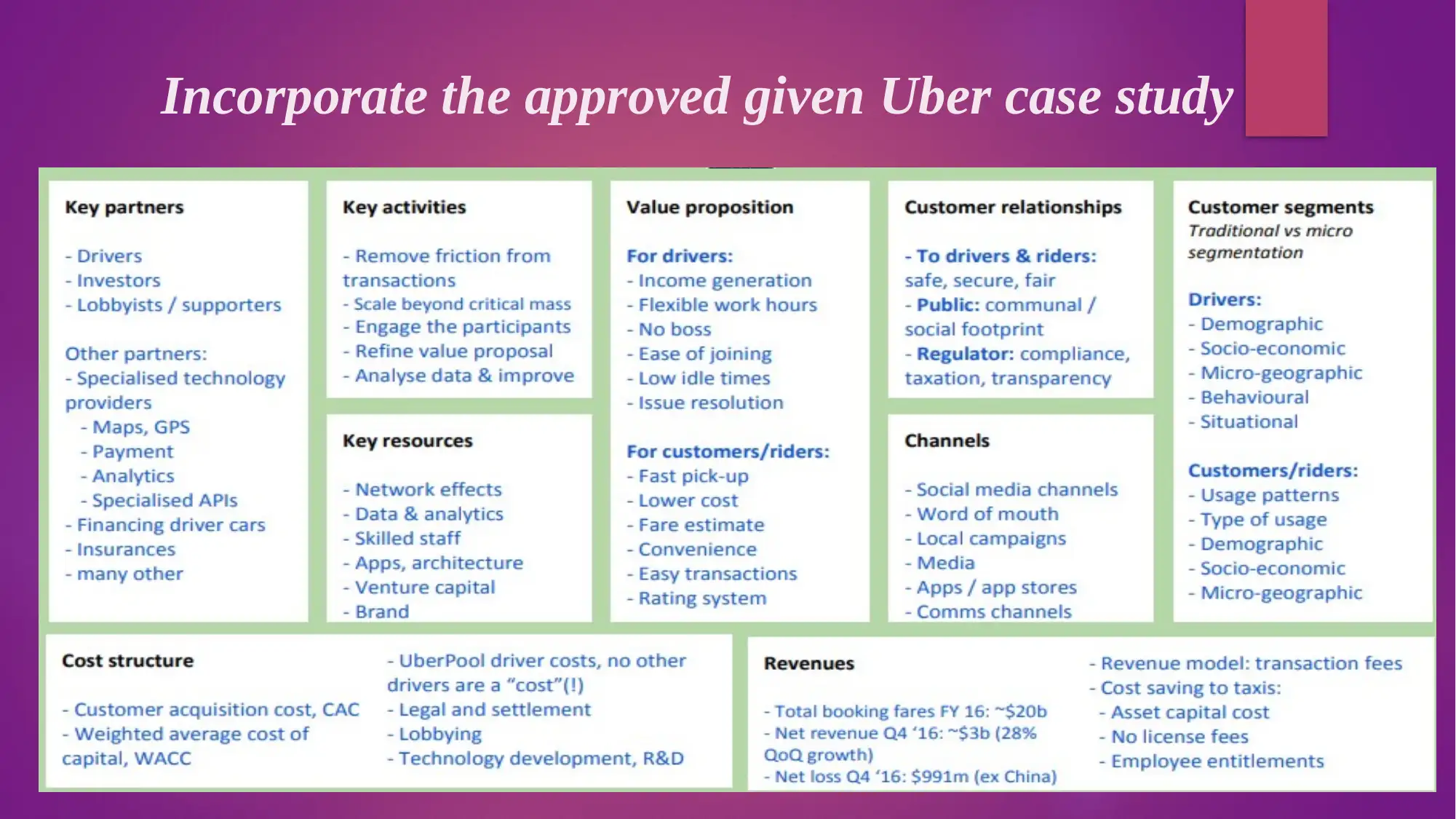
Incorporate the approved given Uber case study
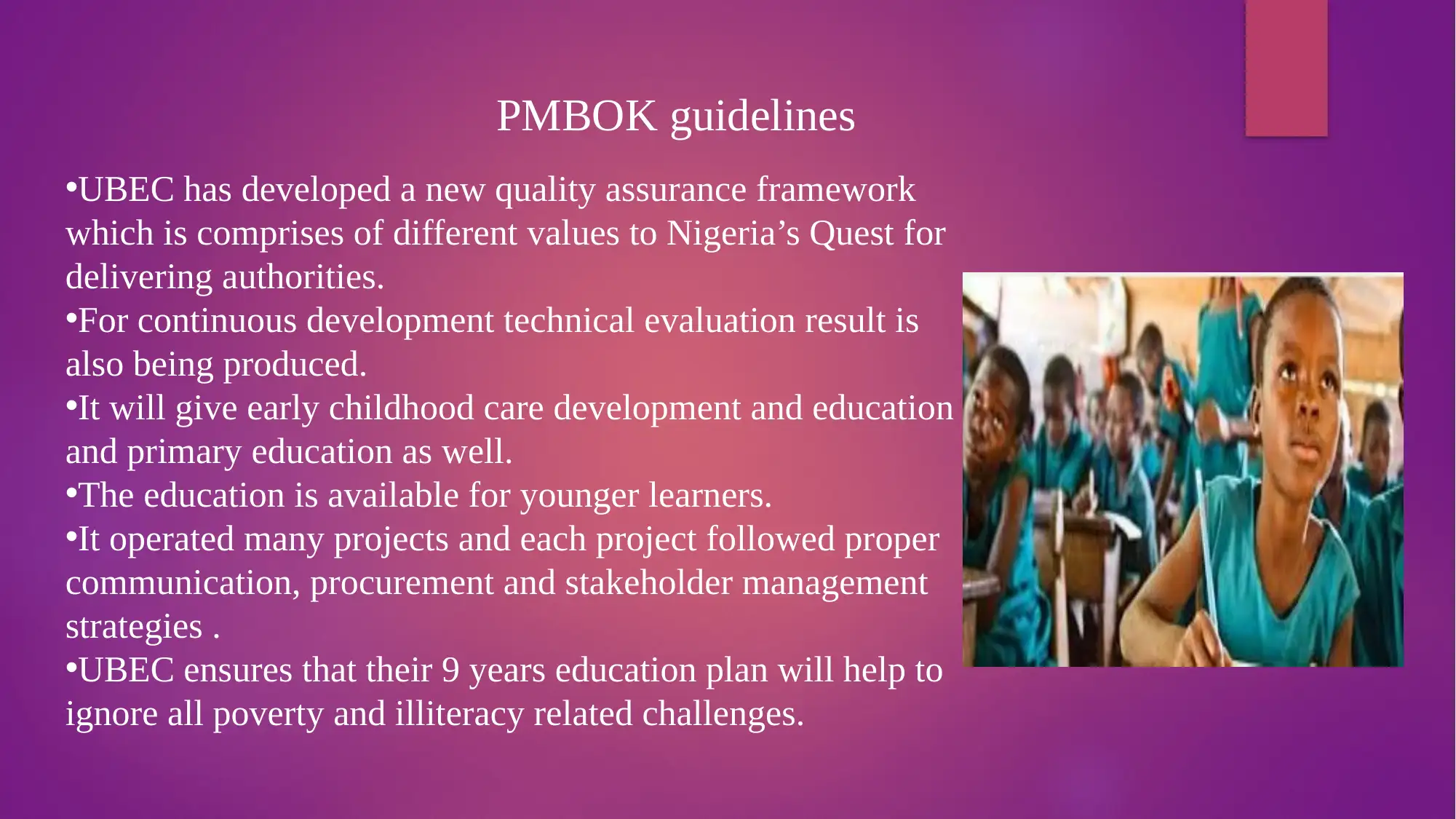
PMBOK guidelines
•UBEC has developed a new quality assurance framework
which is comprises of different values to Nigeria’s Quest for
delivering authorities.
•For continuous development technical evaluation result is
also being produced.
•It will give early childhood care development and education
and primary education as well.
•The education is available for younger learners.
•It operated many projects and each project followed proper
communication, procurement and stakeholder management
strategies .
•UBEC ensures that their 9 years education plan will help to
ignore all poverty and illiteracy related challenges.
•UBEC has developed a new quality assurance framework
which is comprises of different values to Nigeria’s Quest for
delivering authorities.
•For continuous development technical evaluation result is
also being produced.
•It will give early childhood care development and education
and primary education as well.
•The education is available for younger learners.
•It operated many projects and each project followed proper
communication, procurement and stakeholder management
strategies .
•UBEC ensures that their 9 years education plan will help to
ignore all poverty and illiteracy related challenges.
⊘ This is a preview!⊘
Do you want full access?
Subscribe today to unlock all pages.

Trusted by 1+ million students worldwide
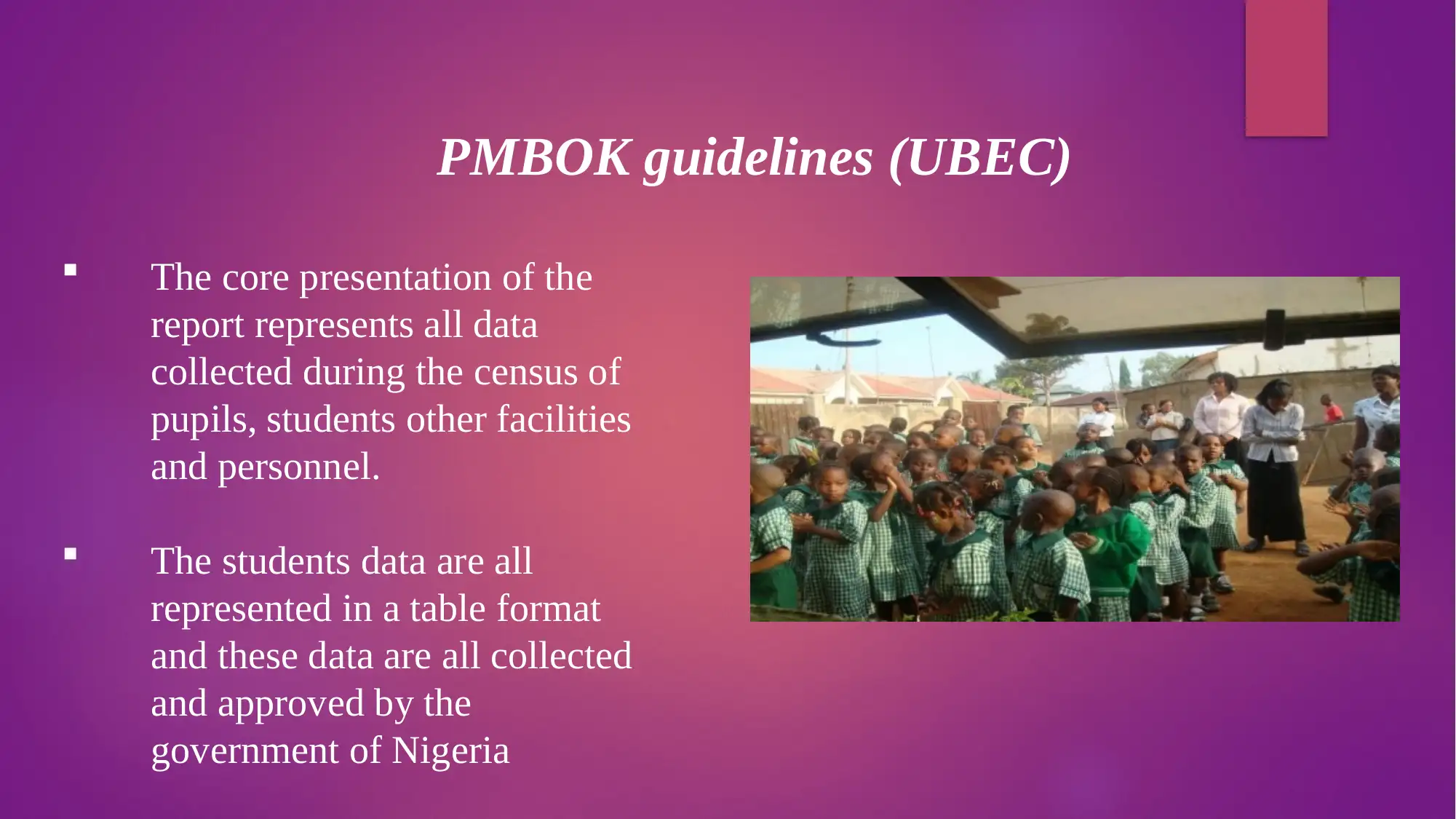
PMBOK guidelines (UBEC)
The core presentation of the
report represents all data
collected during the census of
pupils, students other facilities
and personnel.
The students data are all
represented in a table format
and these data are all collected
and approved by the
government of Nigeria
The core presentation of the
report represents all data
collected during the census of
pupils, students other facilities
and personnel.
The students data are all
represented in a table format
and these data are all collected
and approved by the
government of Nigeria
Paraphrase This Document
Need a fresh take? Get an instant paraphrase of this document with our AI Paraphraser
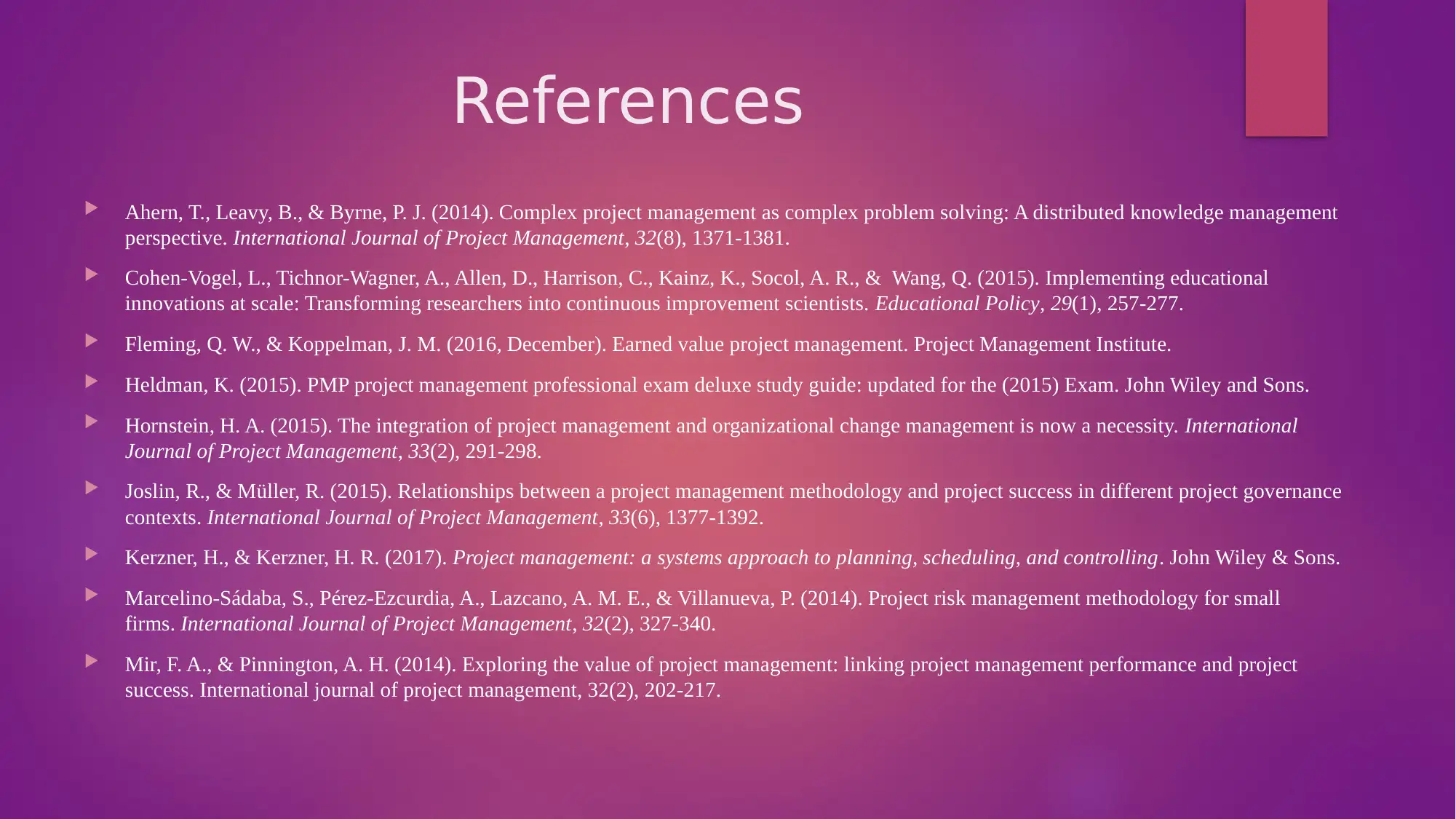
References
Ahern, T., Leavy, B., & Byrne, P. J. (2014). Complex project management as complex problem solving: A distributed knowledge management
perspective. International Journal of Project Management, 32(8), 1371-1381.
Cohen-Vogel, L., Tichnor-Wagner, A., Allen, D., Harrison, C., Kainz, K., Socol, A. R., & Wang, Q. (2015). Implementing educational
innovations at scale: Transforming researchers into continuous improvement scientists. Educational Policy, 29(1), 257-277.
Fleming, Q. W., & Koppelman, J. M. (2016, December). Earned value project management. Project Management Institute.
Heldman, K. (2015). PMP project management professional exam deluxe study guide: updated for the (2015) Exam. John Wiley and Sons.
Hornstein, H. A. (2015). The integration of project management and organizational change management is now a necessity. International
Journal of Project Management, 33(2), 291-298.
Joslin, R., & Müller, R. (2015). Relationships between a project management methodology and project success in different project governance
contexts. International Journal of Project Management, 33(6), 1377-1392.
Kerzner, H., & Kerzner, H. R. (2017). Project management: a systems approach to planning, scheduling, and controlling. John Wiley & Sons.
Marcelino-Sádaba, S., Pérez-Ezcurdia, A., Lazcano, A. M. E., & Villanueva, P. (2014). Project risk management methodology for small
firms. International Journal of Project Management, 32(2), 327-340.
Mir, F. A., & Pinnington, A. H. (2014). Exploring the value of project management: linking project management performance and project
success. International journal of project management, 32(2), 202-217.
Ahern, T., Leavy, B., & Byrne, P. J. (2014). Complex project management as complex problem solving: A distributed knowledge management
perspective. International Journal of Project Management, 32(8), 1371-1381.
Cohen-Vogel, L., Tichnor-Wagner, A., Allen, D., Harrison, C., Kainz, K., Socol, A. R., & Wang, Q. (2015). Implementing educational
innovations at scale: Transforming researchers into continuous improvement scientists. Educational Policy, 29(1), 257-277.
Fleming, Q. W., & Koppelman, J. M. (2016, December). Earned value project management. Project Management Institute.
Heldman, K. (2015). PMP project management professional exam deluxe study guide: updated for the (2015) Exam. John Wiley and Sons.
Hornstein, H. A. (2015). The integration of project management and organizational change management is now a necessity. International
Journal of Project Management, 33(2), 291-298.
Joslin, R., & Müller, R. (2015). Relationships between a project management methodology and project success in different project governance
contexts. International Journal of Project Management, 33(6), 1377-1392.
Kerzner, H., & Kerzner, H. R. (2017). Project management: a systems approach to planning, scheduling, and controlling. John Wiley & Sons.
Marcelino-Sádaba, S., Pérez-Ezcurdia, A., Lazcano, A. M. E., & Villanueva, P. (2014). Project risk management methodology for small
firms. International Journal of Project Management, 32(2), 327-340.
Mir, F. A., & Pinnington, A. H. (2014). Exploring the value of project management: linking project management performance and project
success. International journal of project management, 32(2), 202-217.
1 out of 11
Related Documents
Your All-in-One AI-Powered Toolkit for Academic Success.
+13062052269
info@desklib.com
Available 24*7 on WhatsApp / Email
![[object Object]](/_next/static/media/star-bottom.7253800d.svg)
Unlock your academic potential
Copyright © 2020–2025 A2Z Services. All Rights Reserved. Developed and managed by ZUCOL.





